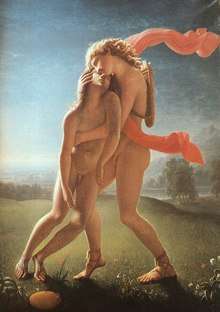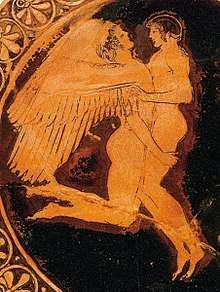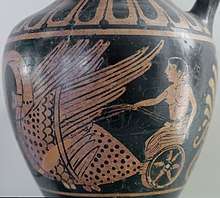Hyacinth (mythology)
Hyacinth /ˈhaɪəsɪnθ/ or Hyacinthus (Ancient Greek: Ὑάκινθος Huákinthos) is a divine hero and a lover of Apollo from Greek mythology. His cult at Amyclae southwest of Sparta dates from the Mycenaean era. A temenos or sanctuary grew up around what was alleged to be his burial mound, which was located in the Classical period at the feet of Apollo's statue.[1] The literary myths serve to link him to local cults, and to identify him with Apollo.

Family

Hyacinth was given various parentage, providing local links, as the son of Clio and Pierus,[2] or of king Oebalus of Sparta,[3] or of king Amyclus of Sparta,[4][5] progenitor of the people of Amyclae, dwellers about Sparta. As the youngest and most beautiful son of the latter and Diomedes, daughter of Lapithes, Hyacinth was the brother of Cynortus, Argalus,[5] Polyboea,[6] Laodamia[7] (or Leanira[8]), and in other versions, of Daphne.[9]
Mythology
_-_Apollo_e_Giacinto%2C_inc._da_Annibale_Carracci%2C_-1675-.jpg)
In Greek mythology, Hyacinth was a very beautiful Spartan prince and lover of the god Apollo. Hyacinth was also admired by the West wind Zephyrus, the North wind Boreas and also by a mortal man named Thamyris. But Hyacinth chose Apollo over the others. The couple indulged themselves in hunting and climbing steep, rough mountains around Sparta. With Apollo, Hyacinth visited all of Apollo's sacred lands in the chariot drawn by swans. Apollo taught to his lover the use of bow, of music and the lyre, the art of prophecy and exercises in the gymnasium.[10]
One day, Apollo was teaching him the game of quoit. They decided to have a friendly competition by taking turns to throw the discus. Apollo threw first, with such a strength that the discus slit the clouds in the sky. Hyacinth ran behind it to catch it and impress Apollo. But as the discus hit the ground, it bounced back, hitting Hyacinth's head and wounding him fatally.[2] Alternatively, Zephyrus is held responsible for the death of Hyacinth.[11][12][13][14] Jealous that Hyacinth preferred the radiant Apollo, Zephyrus blew Apollo's quoit boisterously off course to kill Hyacinth.
Apollo's face turned as pale as his dying lover as he held him in his arms.[15] He used all his medicinal skills, and even tried giving ambrosia to heal Hyacinth's wound, but in vain, for he couldn't cure the wound done by the Fates.[16] When Hyacinth died, Apollo wept, blaming himself. He wished to become a mortal and join his lover in his death.[17] However, as that was not possible, Apollo promised that he would always remember Hyacinth in his songs and the music of his lyre. From Hyacinth's blood that was spilled, Apollo created a flower, the hyacinth. This flower, on whose petals Apollo had inscribed the words of despair, "AI AI" – "alas" was considered by the Greeks to be the most beautiful of all flowers.[15]
The Bibliotheca said Thamyris who showed romantic feelings towards Hyacinthus, was the first man to have loved another man.[2]
Apotheosis and Hyacinthia
Hyacinth was eventually resurrected by Apollo and attained immortality.[18] Pausanias has recorded that the throne of Apollo in Sparta had the depiction of bearded Hyacinth being taken to heaven along with his sister Polyboea by Aphrodite, Athena and Artemis.[6]
Hyacinthus was the tutelary deity of one of the principal Spartan festivals, Hyacinthia, celebrated in the Spartan month of Hyacinthia (in early summer). The festival lasted three days, one day of mourning for the death of Hyacinth, and the last two celebrating his rebirth, though the division of honours is a subject for scholarly controversy.[19] On the first day, people mourned his death by eating as little as possible and abstaining from singing songs, contrary to all the other festivals of Apollo. On the second day, choirs of boys and young men sang some of their national songs, and danced. As for the girls, some were carried in decorated wicker carts and others paraded in chariots pulled by two horses, which they raced. Citizens entertained their friends and even their own servants.[20] Every year the Laconian women wove a chiton for Apollo and presented it to him, a tradition similar to the peplos offered to Athena at Athens upon the occasion of the Panathenaic Games.[21] Less is known about the third day, indicating that probably mysteries were held. It is described as "merry midnight festival".[22]
So important was this festival that Amyclaeans, even when they had taken the field against an enemy, always returned home on the approach of the season of the Hyacinthia,[23][24] and that the Lacedaemonians on one occasion concluded a truce of forty days with the town of Eira, merely to be able to return home and celebrate the national festival.[25] After the treaty with Sparta, B.C. 421, the Athenians, in order to show their good-will towards Sparta, promised every year to attend the celebration of the Hyacinthia.[26]
Cults and attributes
_-_Museo_Nacional_Thyssen-Bornemisza_Madrid.jpg)
Hyacinthus had a shrine in Amyclea which he came to share with Apollo. Various scholars agree that Hyacinthus was a pre-hellenic nature god, and certain aspects of his own cult suggest that he was a chthonic vegetation deity whose cults were merged with Apollo's. Nilsson says that Hyacinthus is a Cretan word, and its pre-hellenic origin is indicated by the suffix -nth.[27] Hyacinthus impersonates the sprouting vegetation in spring, which is killed by the heat of the summer.[28] The apotheosis of Hyacinthus indicates that after attaining godhood, he represented the natural cycle of decay and renewal.[29]
The fact that at Tarentum a Hyacinthus tomb is ascribed by Polybius to Apollo Hyacinthus (not Hyacinthus) has led some to think that the personalities are one, and that the hero is merely an emanation from the god; confirmation is sought in the Apolline appellation τετράχειρ, alleged by Hesychius to have been used in Laconia, and assumed to describe a composite figure of Apollo-Hyacinthus. Against this theory is the essential difference between the two figures. Hyacinthus is a chthonian vegetation god whose worshippers are afflicted and sorrowful; Apollo, though interested in vegetation, his death is not celebrated in any ritual, his worship is joyous and triumphant, and finally the Amyclean Apollo is specifically the god of war and song. Moreover, Pausanias describes the monument at Amyclae as consisting of a rude figure of Apollo standing on an altar-shaped base which formed the tomb of Hyacinthus. Into the latter offerings were put for the hero before gifts were made to the god.[30][31][32]
Hyacinthus was gifted a swan chariot by Apollo and appeared in ancient arts riding it, either to meet Apollo or to escape the advances of Zephyrus.[33] Swans were believed to be the birds of Hyperborea, a mystical land of eternal spring and immortality, to which Apollo himself traveled every winter on a chariot drawn by swans.[34][35] This association of Hyacinth with swans places him in close connection to Hyperborean Apollo and spring. It is suggested that Hyacinthus would have spent the winter months in the underworld, or more suitably Hyperborea and returning to earth in the spring when the hyacinth flower blooms.[36]
According to classical interpretations, his myth is a metaphor of the death and rebirth of nature. The festival Hyacinthia included the initiatory rites, that is, the initiation of youths into adulthood.
Attributes
The flower hyacinth that rose from Hyacinth's blood is said to have had a deep blue hue and an inscription resembling "AI" on its petals, a symbol of sorrow. However, this flower has been identified with another plant, the larkspur, or an iris, rather than what we today call hyacinth.[37]
Ancient Greeks associated with Apollo a deep blue, or violet precious gem called hyacinth. It was called so because its color resembled that of the hyacinth flowers. This gem was held sacred to Apollo due to the mythological connection. The people who visited Apollo's shrine, as well as his priests and the high priestess Pythia, were required to wear this gem.[38]
"Hyacinthine hair" is used by the poets to describe curly hair that resembles the curled petals of hyacinth flowers, which in turn resembles the hair of Hyacinth himself. The term could also be descriptive of the color of the hair; either dark, black or deep violet. In Homer's Odyssey, Athena gives Odysseus hyacinthine hair to make him look more beautiful. Edgar Allan Poe, in the poem "To Helen", uses the same term to beautify Helen's hair.[39][40]
See also
- Apollo et Hyacinthus, the Mozart opera.
- The House of Hades, a young adult novel in the "Heroes of Olympus" series by Rick Riordan.
- The Hidden Oracle, another young adult novel in the "Trials of Apollo" series of the Camp Half-Blood chronicles by Rick Riordan.
Notes
- There have been finds of sub-Mycenaean votive figures and of votive figures from the Geometric Period, but with a gap in continuity between them at this site: "it is clear that a radical reinterpretation has taken place," Walter Burkert has observed, instancing many examples of this break in cult during the "Greek Dark Ages", including Amykles (Burkert, Greek Religion, 1985, p 49); before the post-war archaeology, Machteld J. Mellink, (Hyakinthos, Utrecht, 1943) had argued for continuity with Minoan origins.
- Pseudo-Apollodorus, Bibliotheca 1.3.3
- Lucian, Dialogi Deorum 16
- Pseudo-Apollodorus, Bibliotheca 3.10.3
- Pausanias, Graeciae Descriptio 3.1.3
- Pausanias, Graeciae Descriptio 3.19.4
- Pausanias, Graeciae Descriptio 10.9.5
- Pseudo-Apollodorus, Bibliotheca 3.9.1
- Parthenius, Erotica Pathemata 15
- Philostratus the younger, Imagines
- Lucian, Dialogues of the Gods
- Maurus Servius Honoratus, commentary on Virgil Eclogue 3. 63
- Philostratus of Lemnos, Imagines 1.24
- Ovid, Metamorphoses 10.184
- Ovid, Metamorphoses
- Bion, Poems 11 (trans. Edmonds)
- Ovid, Metamorphoses 10. 162
- Nonnus, Dionysiaca 19.102
- As Colin Edmonson points out, Edmonson, "A Graffito from Amykla", Hesperia 28.2 (April - June 1959:162-164) p. 164, giving bibliography note 9.
- Athenaeus, Deipnosophists 4.139
- Pausanias, Description of Ancient Greece 3.16.2
- Euripides, Helen
- Xenophon, Hellenics IV.5 § 11
- Pausanias, Description of Ancient Greece 3.10 § 1
- Pausanias Description of Ancient Greece 4.19 § 3
- Thucydides, V.23
- Bernard C. Dietrich, The Origins of Greek Religion
- Schömann, Alterth. 2.404
- Annamarie Hemingway, Immortal Yearnings: Mystical Imaginings and Primordial Affirmations of the Afterlife
- L. R. Farnell, Cults of the Greek States, vol. iv. (1907)
- J. G. Frazer, Adonis, Attis, Osiris (1906)
- Roscher, Lexikon d. griech. u. röm. Myth., s.v. Hyakinthos (Greve)
- Michael Petersson, Cults of Apollo at Sparta: the hyakinthia, the gymnopaidai and the karneia
- Frederick M. Ahl, Amber, Avallon, and Apollo's Singing Swan
- Callimachus, Hymn to Apollo
- Frederick M. Ahl, Amber, Avallon, and Apollo's Singing Swan
- Other divinely beloved vegetation gods who died in the flower of their youth and were vegetatively transformed are Narcissos, Cyparissos and Adonis.
- A. Hyatt Verrill, Precious Stones and Their Stories
- M. Eleanor Irwin, Odysseus' "Hyacinthine Hair" in "Odyssey" 6.231
- Shmoop Editorial Team. "To Helen: Stanza 2 Summary." Shmoop. Shmoop University, Inc., 11 Nov. 2008. Web. 16 Nov. 2018.
References
- Gantz, Timothy (1993). Early Greek Myth. Baltimore: Johns Hopkins University Press.
- Kerenyi, Karl (1959). The Heroes of the Greeks. New York/London: Thames and Hudson.
Spoken-word myths - audio files
| The Hyacinth myth as told by story tellers |
|---|
| Bibliography of reconstruction: Homer, Iliad ii.595-600 (c. 700 BC); Various 5th century BC vase paintings; Palaephatus, On Unbelievable Tales 46. Hyacinthus (330 BC); Pseudo-Apollodorus, Bibliotheca 1.3.3; Ovid, Metamorphoses 10. 162-219 (1–8 AD); Pausanias, Description of Greece 3.1.3, 3.19.4 (160 – 176 AD); Philostratus of Lemnos, Images i.24 Hyacinthus (170–245); Philostratus the Younger, Images 14. Hyacinthus (170–245); Lucian, Dialogues of the Gods 14 (170); First Vatican Mythographer, 197. Thamyris et Musae |
External links
| Wikimedia Commons has media related to Hyacinthus. |
